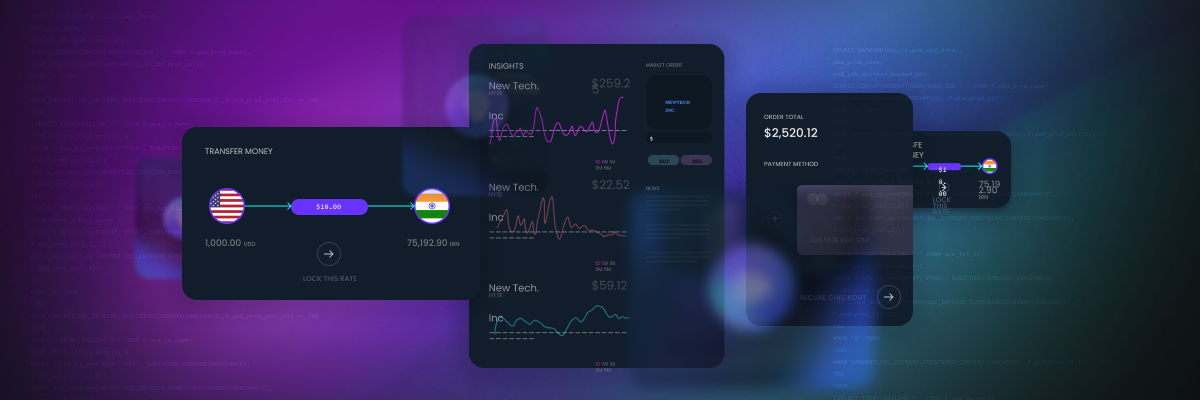When you're in charge of processing payments, or managing your customers’ access to their banking app, or even delivering a reliable platform for your developers to build on – there’s a lot at stake. Brand reputation, customer satisfaction, employee retention, and revenue growth all depend on a stable, performant infrastructure.
Financial service applications arguably have the most stringent database requirements when it comes to high availability, performance, and data correctness. They also need their infrastructure to be scalable so that they can accommodate a growing customer base and handle large transactional volumes. Engineering teams don’t want to deal with challenges like sharding, planned downtime, and hours of code refactoring that come with using a legacy solution.
Instead, financial service companies are using a distributed SQL database to meet application requirements and achieve business goals. The team at Cockroach Labs has worked with dozens of companies (including Fortune 50 banks) that use CockroachDB to support the following initiatives and use cases.
#1 Building a highly available payments system designed for correctness
When it comes to payment and billing systems, there are two crucial components: 24/7 availability and data correctness. Organizations need to make sure that their platform is up and running, and that they never process a payment twice. However, achieving 99.999% availability and data consistency can be complicated when your transactions are distributed and concurrent.
Let’s say a global payments company builds a majority of their applications and services on PostgreSQL and has data centers distributed around the world. While PostgreSQL is a powerful, reliable relational database, it also has some limitations: manual sharding, downtime for maintenance, active/passive setup, and limited writes. PostgreSQL requires you to take down the database for upgrades – once a year, once a month, or maybe more. Since the system is processing payments, any amount of downtime is not acceptable.
With PostgreSQL, replication can be complicated with a primary and multiple secondaries in many places. And you are not able to write from every location since there’s a single writer node which exists in a single data center. In short, you have to go back to the same data center for your write load which creates bottlenecks when scaling.
Instead, with CockroachDB, a payments use case can take advantage of rolling upgrades and online schema changes so there’s no need to take the database down for maintenance. CockroachDB has built-in replication with the ability to distribute data across geographies while still guaranteeing data correctness. Additionally, CockroachDB is a fully distributed database and every node accepts reads and writes which makes it easier to build a scalable payment system designed for correctness without all the operational burden.
#2 Delivering an internal database-as-a-service for all developers
Large financial institutions often have a suite of database offerings available for their developers to choose from when building applications and services. They also often have teams dedicated to managing database systems such as Platform Engineering or Infrastructure Engineering.
Delivering a database-as-a-service platform allows developers to quickly choose the right solution that suits their use case needs. There’s typically traditional relational databases available such as PostgreSQL and MySQL, and NoSQL databases such as Cassandra and MongoDB.
More and more financial institutions are finding a greater need to add a distributed SQL database to their stack. A database like CockroachDB is a good fit if their use case requires a multi-region deployment, with guaranteed data consistency.
Since CockroachDB is cloud-native, developers also have the ability to choose a deployment model: on-premise, public cloud, or hybrid. This is a significant advantage from other distributed SQL offerings that lock you in to using a single cloud provider.
#3 Migrate core banking services off the mainframe
Global financial service organizations often are operating under a major company-wide initiative to move their applications off of legacy technologies and mainframe systems (commonly Oracle and Db2).
At a bank, there can be several “mainframe-offload” projects which may include: the central repository for customer information around the world, a system of record for commercial/community deposits, and card payments which is debt that the bank is owed.
Legacy databases create a ton of complications for teams including inconsistent customer records, heavy operational complexity associated with managing millions of transactions, scaling to accommodate new growth, and much more. Plus, these outdated systems put them at risk for outages.
For example, let’s say a company’s core deposit system is running on a mainframe. Unexpectedly, a hurricane hits a particular area and impacts two of their data centers which takes their business offline in that region. For a period of time, their customers in that region would not be able to access their financial data. Typically on mainframes, companies can not survive a regional outage which causes a loss of revenue, exposes regulatory fines, creates disaster recovery costs, and puts their customers' sensitive data at risk.
Banks use CockroachDB to modernize their applications because it delivers resilient/highly available infrastructure, guarantees consistent transactions, provides the flexibility to deploy across multiple regions, allows you to pin data to a location, works with other modern technologies (like Kubernetes), and can scale to accommodate heavy transactional workloads.
Organizations will often run a multi-region CockroachDB cluster across multiple data centers spread out among (at least) three cloud regions. Given emerging global regulations around operational resilience, many banks are preparing to add a second public cloud provider to their technology stack and run across multiple clouds.
#4 Supporting foundation for a digital bank 
In today’s digital age, some banks are eliminating brick & mortar stores and taking all their services online. The “online-only” or rather “digital” consumer bank model allows organizations to scale out to a large, global audience.
When building a digital consumer bank, there’s typically several application and business requirements that can benefit from using a distributed SQL database. For example, using a database that can horizontally scale transactions will make it easier for the company to grow and onboard new customers.
When the bank is “branchless,” online services must always be on and available at any time of the day. Customers need instantaneous access to their banking information and a disruption in service is unacceptable. It’s beneficial for an organization to run their digital banking application across multiple regions (and clouds) to achieve operational resilience. It’s also helpful if the database allows you to pin data to a particular region to meet the data privacy requirements of that location.
A digital bank also requires a database with ACID guarantees. Many organizations report that failed payments are the biggest cause of decreased customer satisfaction and they never want to miss a payment because of data inconsistencies.
CockroachDB delivers the capabilities a company needs for a digital consumer bank: horizontal scale, always-on availability, multi-cloud/hybrid-cloud environment, the ability to tie data to a location to aid with various data compliance regulations, and guaranteed data consistency.
#5 Ensuring seamless identity access management 
IAM systems are mission critical for financial service organizations because they allow users or services to gain access to the right systems and data at the right time. Usually IAM comes in two forms: authentication or authorization. Authentication verifies the identity of a user/service, whereas authorization allows the user/service to gain access to parts of a system and data.
This use case requires a database that can deliver fast, consistent access to users regardless of their location. IAM systems cannot go offline because the business impact is too substantial. Every minute that authentication or authorization systems are down, the company loses money and their customers’ trust. Even planned downtime for maintenance or software upgrades is unacceptable, since many financial service organizations serve a global audience spanning different time zones.
Catering to global users also creates challenges when it comes to maintaining high availability. You want your database to be physically located close to users for fast access, yet you also need to make sure that you replicate your authentication data to a backup region. In the event of a node, zone, or region failure, chaos can ensue.
Additionally, data inconsistencies can cause major security issues when authorizing users (i.e. the right permissions aren’t attached to their profile). As you continue to scale the volume of users, more inconsistencies can be introduced if you aren’t using a resilient database system that guarantees data correctness through synchronous data replication.
Because most IAM systems cater to users or systems that are distributed in different locations, they require a distributed database like CockroachDB that can span multiple regions and/or data centers and have the ability to domicile data in a particular location to aid with compliance. A multi-region database also allows you to maintain high availability in the event of a total region failure.
IAM systems must be able to handle an increase in users and/or services added to the system. They require a distributed database that can seamlessly adapt to an uptick in workloads without causing outages or the need for complex manual sharding configurations. Even as you scale, your data must always be consistent, which requires a database with ACID guarantees to ensure data integrity is maintained.
CockroachDB for financial services 
As the stress on financial service applications increases, organizations need a database that can offer key support. With guaranteed ACID transactions, data consistency, flexible deployment options, data residency features, and more, CockroachDB offers a reliable foundation for financial service organizations. From providing seamless IAM and highly available payments systems, to database-as-a-service and mainframe modernization support, CockroachDB will meet you where you are.
You can visit our customer page to read more stories, or get in touch with an expert to see how CockroachDB can help your organization.





